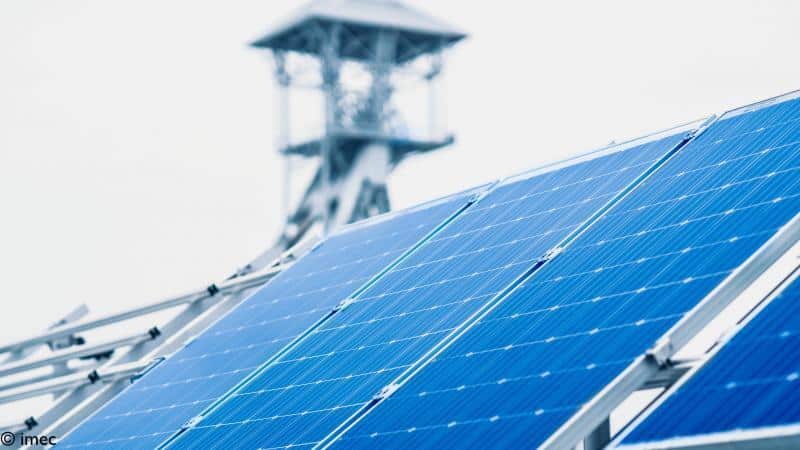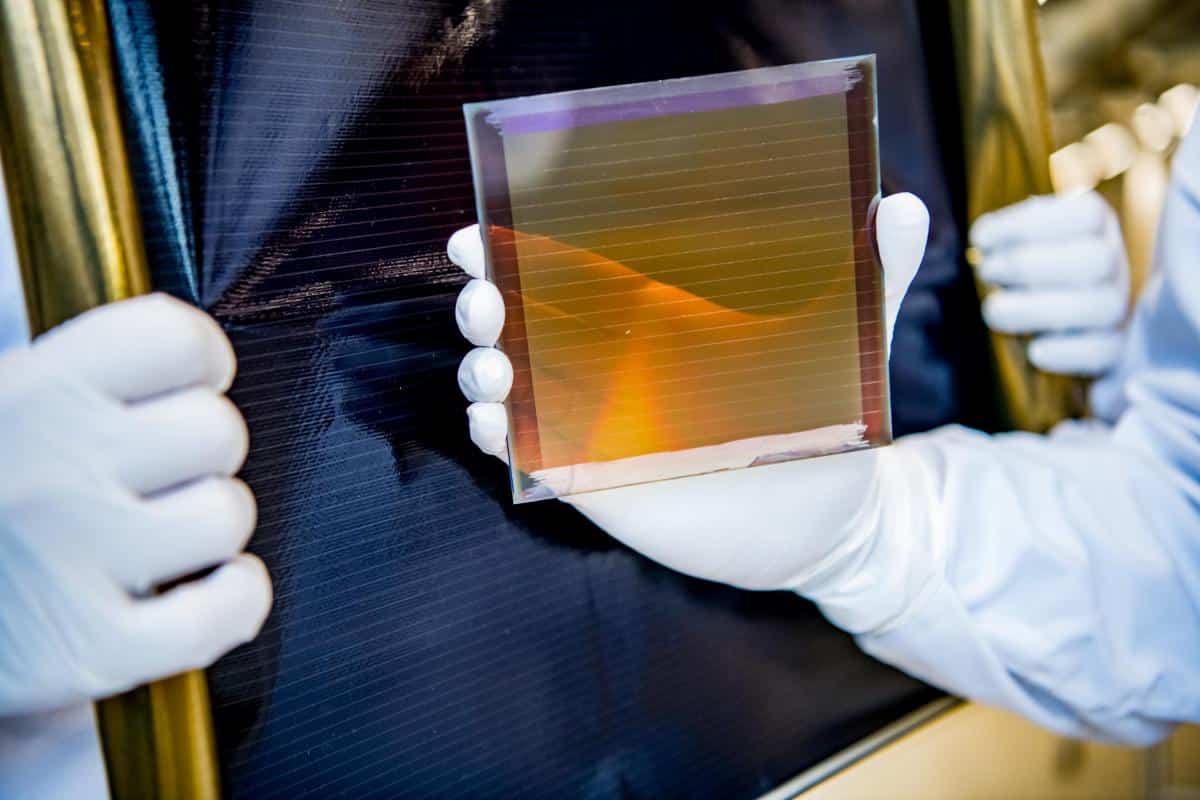Expert talk: how lifecycle thinking can accelerate the development of more sustainable emerging photovoltaic technologies
Innovative PV technologies such as perovskite are gaining attention due to their promising technical performance and the opportunity to be manufactured with low-cost materials and techniques. They depend, however, on achieving technical, economic, and environmental sustainability targets to enhance marketability. To quantify and visualise these parameters, ETEA-analysis play an important part. In this expert talk Alessandro Martulli (EnergyVille/UHasselt) will guide you through the what, why and how of ETEA analyses.
Decarbonising the energy system is one of the European Union’s (EU) goals to achieve the greenhouse gas emission (GHG) reduction target of 55% for 2030 compared with 1990 levels and full carbon neutrality by 2050 as stipulated by the Green Deal. A power sector drawing largely upon renewable energy sources is a critical component to reach these targets. Solar energy can be an important source in such a power system because of the carbon-free electricity generated in the use phase of photovoltaic (PV) technologies.1

Since the 1970s, PV technology has undergone continuous innovation to develop less costly, more efficient, and longer-lasting solar cells. Most of the PV technologies currently available on the market comprise the so-called 1st generation devices made of crystalline silicon (c-Si). Their success is due to high power conversion efficiency (PCE), the relative abundance of silicon, standard and optimised manufacturing leading to the low electricity generation cost. Alongside the silicon-based PVs, a wide variety of alternative materials have been investigated to develop PV technologies with PCE close to 30%, produced at a low cost, on flexible substrates, and with a reduced environmental impact compared to 1st generation technologies. Among these, perovskite solar cells (PSCs) receive increased attention due to their unique optical and electronic properties, low-cost material, and the easy processing techniques that may be employed. Furthermore, researchers have succeeded in rapidly increasing the PCE of perovskite solar cells from less than 4% to 25.5% over the last ten years, as shown in Figure 1, representing the best PCEs achieved by research on PV technologies.2 Therefore, PSCs are now considered one of the most promising technologies for the next generation of solar cells.

Figure 1: Best PV research-cell efficiency chart2
The successful commercialisation of innovative PV technologies depends on the “solar cell golden triangle” (Figure 2) comprising three crucial performance indicators: efficiency, lifetime, and cost. Besides, low toxicity and manufacturability are conducive to easier upscaling.3 At present, despite the remarkable achievements in PCE performance, several issues related to lifetime and scalability represent a potential barrier to the marketability of perovskite PVs. Although the stability has increased from few minutes to several thousand
hours and larger-area devices have been developed in the last few years4, PSC performance still lags behind traditional technologies such as c-Si and CIGS (Copper-gallium-indium-selenide) Improving the sustainability of PV technologies by minimising environmental impacts from materials usage and processes is also one of the main concerns for commercialisation. One of the critical issues for perovskite PVs, in this case, is the presence of lead (Pb) and the related impacts on the environment and human health derived from its utilisation in the perovskite solution.5

Figure 2: Solar cell performance golden triangle including cost, efficiency, and lifetime for successful commercialisation3
Given the heterogeneity between different perovskite PV device configurations and production techniques, it is essential to assess the available options in technical, economic, and environmental terms to assess the commercial potential and identify critical factors to optimise the technology. The Environmental Techno-Economic Assessment (ETEA) represents a powerful method for analysing the economic and environmental performance of novel technologies such as perovskites PVs in an integrated way. The ETEA integrates the lifecycle assessment (LCA) with the techno-economic analysis (TEA) to quantify financial and environmental key indicators. Conducting separate LCA and TEA does not usually allow for results comparison since the system’s boundaries can be different. Instead, integrating LCA and TEA is judicious as it can provide more insights than a single assessment of environmental and techno-economic performance and thus helps guiding the decision-making process of technology development. This way, the economic and environmental assessments are consistent, and direct linkages and trade-offs can be identified.

Figure 3: ETEA approach main steps: 1) Data collection, 2) Process flow and mass & energy balance definition, 3) Economic & environmental analysis, and 4) Uncertainty analysis 6
The integration of LCA and TEA has been growingly employed in the academic literature over the last years. 7,8 Specifically, the ETEA approach has been developed jointly by Hasselt University, VITO and University of Antwerp to assess emerging clean technologies’ financial and environmental sustainability.9,10 As illustrated in Figure 3, this framework generally involves an initial phase of collecting relevant data to model the process/product to be analysed. The process flow diagram and mass and energy balance are modelled in the second step, including the mass and energy input/output for the process under consideration. In the third step, the economic feasibility and environmental impact are assessed where the economic and environmental analysis are directly linked with the mass and energy balance from the second step. This link allows for the direct identification of the parameters that influence economic feasibility and environmental performance. The analysis’ goal is computing relevant indicators for the product/process under study. Since the results may be uncertain at low technology development stages, usually a risk analysis is performed to determine the parameters with the highest impact on the indicators’ variance. One of the main advantages of this methodology is its compatibility with life cycle thinking, and therefore, the economic and environmental indicators can be calculated at different lifecycle stages (e.g., manufacturing and/or use phase). Moreover, the impact of the end-of-life phase and recycling strategies can be included in the analysis, enabling a more holistic assessment of the key indicators.

The ETEA methodology is suitable for assessing photovoltaic technologies throughout their lifecycle. For innovative PV technologies, an ETEA model allows estimating two relevant economic indicators: the minimum sustainable price (MSP, e.g., lowest price value for a PV manufacturer to be financially sustainable) and the levelised cost of electricity (LCOE, e.g., cost of generating electricity). The environmental sustainability is assessed through the energy payback time (EPBT, e.g., the time required for the system assessed to generate the same quantity of energy needed to produce the system itself) and the greenhouse gas emission factor (GEF, e.g., lifecycle GHG emissions per kWh of electricity generated). In this regard, it is essential to evaluate all opportunities for cost and environmental impact reductions these technologies present throughout their lifetime. Among them is the potential of end-of-life techniques to recover expensive and impactful materials and/or energy employed in the manufacturing process. Consequently, the successful end-of-life recovery may reduce the cost incurred by the PV manufacturer and the environmental impacts caused by the utilisation of materials and energy, thus facilitating the achievement of the sustainability targets required for successful commercialisation. The ETEA method then analyses the PV technology under development, and hence it provides an accurate estimate of its economic and environmental performance throughout the lifecycle. The results obtained can be compared to benchmarks, in case of photovoltaic applications, usually the leading PV technologies currently dominating the market (e.g., c-Si and CIGS).
For example, a preliminary Environmental Techno-Economic Assessment performed on a carbon-electrode-based perovskite PV device found the minimum sustainable price and LCOE to be comparable to those provided by c-Si and CIGS technologies. Environmental indicators, such as energy payback and GEF, also resulted in values close to those reported for benchmark PVs. Although comparable, the performance of perovskite PVs is yet not superior to the conventional technologies, and this is because, as often, promising technologies at the low development stage show higher costs and environmental impact. However, through the ETEA implementation, it is possible to identify opportunities for improving environmental and techno-economic sustainability. For example, it allows to consider the entire lifecycle of carbon-based perovskite PVs and investigate the impact of available recycling processes on the economic and environmental indicators. As such, the preliminary results from the analysis highlight the importance of recycling in the end-of-life phase (excluding transport-related cost and environmental impact) since this allows considerable cost and environmental impact reductions for sufficient levels of materials recovery. In this case, it is assumed that the perovskite PV manufacturer is responsible to collect the dismissed perovskite PV devices once these reach end-of-life and to implement a recycling process. Through this process, the manufacturer could recover materials which then could be employed in the production process of new perovskite devices; as a consequence, the costs for material acquisition and the process related environmental impacts are found to be considerably reduced. Thus, this represents one way to further reduce the costs and environmental impacts of production and facilitate perovskite PVs commercialization. In fact, it is found that the successful implementation of recycling techniques may help perovskite PVs reducing the environmental and economic gap with the benchmark PV technologies as price and GHG emissions related indicators may experience moderate decreases for high levels of material recovery.
Key takeaways
- Among emerging PV technologies, the attention to perovskite solar PVs has grown due to their promising technical performance and the opportunity to be manufactured with low-cost materials and techniques.
- Innovative PV technologies such as perovskite depend on achieving technical, economic, and environmental sustainability targets to enhance marketability.
- Provided the variety of perovskite PV configurations, the ETEA provides an integrated assessment approach to relatively estimate a PV technology’s performance, compare it by benchmarking and identify pathways towards more successful commercialisation.
- Contact EnergyVille if in need of a partner to demonstrate the prospective life cycle sustainability of emerging PV technologies
Written by Alessandro Martulli (EnergyVille/UHasselt). Alessandro Martulli is a PhD student of EnergyVille and the Environmental Economics research group within the Centre for Environmental Science at Hasselt University (Belgium). He is currently working in the EU Horizon 2020 project PERCISTAND, and his main activities involve carrying out techno-economic analyses of the development of perovskite/CIS tandem PV technologies. He holds a Bachelor’s Degree in Management Engineering (Polytechnic University of Bari) and a Master’s Degree in Energy and Environmental Science (University of Groningen).
References
- Creutzig, F. et al. The underestimated potential of solar energy to mitigate climate change. Nature Energy (2017) doi:10.1038/nenergy.2017.140.
- NREL. Best Research-Cell Efficiency Chart. https://www.nrel.gov/pv/cell-efficiency.html (2020).
- Meng, L., You, J. & Yang, Y. Addressing the stability issue of perovskite solar cells for commercial applications. Nature Communications (2018) doi:10.1038/s41467-018-07255-1.
- Wang, R. et al. A Review of Perovskites Solar Cell Stability. Advanced Functional Materials (2019) doi:10.1002/adfm.201808843.
- Li, H. & Zhang, W. Perovskite Tandem Solar Cells: From Fundamentals to Commercial Deployment. Chemical Reviews (2020) doi:10.1021/acs.chemrev.9b00780.
- Van Dael, M., Kuppens, T., Lizin, S. & Van Passel, S. Techno-economic Assessment Methodology for Ultrasonic Production of Biofuels. in (2015). doi:10.1007/978-94-017-9624-8_12.
- Suresh, P. et al. Life Cycle Greenhouse Gas Emissions and Costs of Production of Diesel and Jet Fuel from Municipal Solid Waste. Environ. Sci. Technol. (2018) doi:10.1021/acs.est.7b04277.
- Staples, M. D. et al. Lifecycle greenhouse gas footprint and minimum selling price of renewable diesel and jet fuel from fermentation and advanced fermentation production technologies. Energy Environ. Sci. (2014) doi:10.1039/c3ee43655a.
- Van Dael, M. et al. A techno-economic evaluation of a biomass energy conversion park. Appl. Energy (2013) doi:10.1016/j.apenergy.2012.11.071.
- Thomassen, G., Van Dael, M., Van Passel, S. & You, F. How to assess the potential of emerging green technologies? Towards a prospective environmental and techno-economic assessment framework. Green Chemistry (2019) doi:10.1039/c9gc02223f.